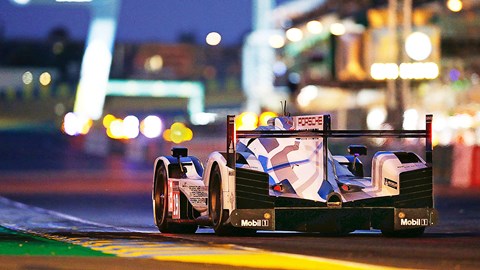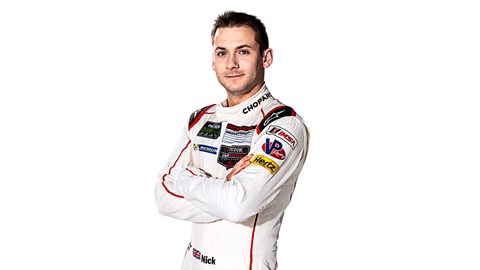► Essential tips from Brit Nick Tandy
► 2016 winner with Bamber and Hulkenberg
► ‘You top 230mph four times a lap’
1) Break the lap down into three parts
‘There’s the flat-out section with chicanes from Tertre Rouge to Mulsanne, the fast area around the Porsche curves, and the slow section with bumpy kerbs around the stadium area and pits. The car does the work more than the driver on the Mulsanne straight, and the stadium area is typical racetrack.’
2) Precision is key
‘The Porsche curves are unique. You need to find your rhythm, work out where the bumps are, and be precise with your line. The racing line rubbers-in, but different classes use different lines. The LMP1 cars take a wider, more sweeping line than the heavier GT cars, so even though the fastest line for an LMP1 car should be on the outside, there might actually be more grip on the inside.’
3) Flat-out all the time? Not quite
‘You have to hold a certain amount of performance in reserve. We have fuel-restricted regulations, and when you’re doing up to three and a half hours on one set of tyres, there’s no point going flat-out. I’m probably at 98-99% until the last 30 minutes of the stint, then I’ll push to the maximum.’
4) Compromise your set-up – you have to
‘We’d like more downforce for the corners but you make more time up in a straight line because you top 230mph four times a lap. The public road section is bumpier, so the suspension is softer. Again it’s a compromise because the stiffer you run the car, the more aero load you can have. We’ll have the set-up to 95% before fine-tuning on race weekend, but the last few per cent can make the difference between winning and losing.’
5) Two hours’ sleep is more than enough
‘I try to sleep as much as possible the night before Le Mans and not get up too early on race day. If I’m tired I’ll sleep, if I’m not I won’t. It’s better to do longer stints at night, when it’s cooler, so each driver has a longer break and can sleep a little. If it’s hot or the conditions are changeable your workload is higher so it’s better to change driver more often.’

6) Get fit, then rest
‘Le Mans is the race we train for most physically, but all that prep is done by race week and you need to relax. I didn’t have to increase my fitness to drive in LMP1. It has higher G-forces but the GT cars move around more, so in some ways you’re working harder. But it is a cramped driving position. Your legs are up in your chest and the bottoms of your feet hurt from the pedals. You have so much adrenaline that you only notice when you’re out of the car.’
7) Easy on the bananas
‘Before the race we have pasta to get the carbs and I don’t eat too many sweets, but you need sugars and salts because you sweat a lot. Some guys have strict diets, and it works for them, but I prefer not to be fussy, then it’s no problem if I can’t get what I planned. And I don’t want to be constantly eating bananas.’
8) Eyes forward
‘I found it less mentally stressful to race in LMP1 than a GT car. When you drive the fastest car you’re only ever looking forward. In GT cars you’re passing slower cars and constantly having to look behind you too.’
9) Spot the plodders
‘When you approach a slower car it’s obvious whether it’s a professional or an amateur at the wheel from the way they’re driving – that comes with experience.’
10) You can make a difference in the dark
‘I like driving in the wet at night; it gives you a chance to make a difference. You have less vision; your peripheral vision is greatly reduced. But because of that you have heightened senses and it’s easier to not lose focus. At night in an LMP1 car, it’s also easier for the traffic you’re overtaking: they see your lights, not just a shape in the mirror.’
11) Don’t fear the rain
‘I’ll be praying for rain this year – our 911 works well in the wet. Having three drivers from northern Europe also helps – I know I’ve probably had more practice in the rain than most drivers! That said, getting in amongst the protoype classes, like we did when we won overall at Atlanta last year [in the US endurance series] is less likely at Le Mans because of the lack of slow corners.’
12) Choose your moment
‘To everyone else in the paddock, ours was the third car in 2015. But we had the same equipment, the same opportunity and we knew we could do it. I first thought we could win just before midnight. Nico [Hulkenberg] was in the car and we were making time. I thought, ‘Now’s the time to flick the switch’. I drove for three and a half hours, and took the lead with a healthy advantage.’
Hard work but worth it
‘Winning Le Mans was an unbelievable feeling. I’d just won the biggest race in the world on my first attempt with Porsche, a manufacturer with all that incredible history. It was the most emotional moment of my entire career.’

To the victor, no LMP1 drive…
Both Audi and Porsche reduced their LMP1 efforts to two cars for 2016, cutting costs after dieselgate. It means, bafflingly, that 2015 winner Tandy will race a 911 RSR at Le Mans 2016 in the GTE PRO class instead. ‘I think I should be in one of the [LMP1] cars!’ says Tandy. ‘I understand the decision but it’s sad that, along with Earl, I won’t be in an LMP1 car.’